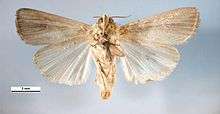Leucania loreyi
| False army worm | |
|---|---|
 | |
| Dorsal view | |
 | |
| Ventral view | |
| Scientific classification | |
| Kingdom: | Animalia |
| Phylum: | Arthropoda |
| Class: | Insecta |
| Order: | Lepidoptera |
| Family: | Noctuidae |
| Genus: | Leucania |
| Species: | L. loreyi |
| Binomial name | |
| Leucania loreyi (Duponchel, 1827) | |
| Synonyms | |
| |
Leucania loreyi, the cosmopolitan or false army worm, is a species of moth of the Noctuidae family. It is found in most of African countries,[1] the Indo-Australian subtropics and tropics of India, Sri Lanka, Myanmar, the eastern Palearctic ecozone and the Near East and Middle East.[2][3]
Description
Wingspan is about 34-44mm.[4] Forewing greyish ochreous; the veins pale lined with brown, the intervals with brown lines; a short black streak from base below cell; median nervure thickly outlined with fuscous to beyond cell; reniform stigma indicated by a white dot at lower angle of cell; outer line by a row of black dots on veins; a triangular brown subapical patch edged above by an oblique pale streak from apex; hindwing white, the veins towards termen fuscous; abdominal tufts beneath formed of coarse scalelike brown black hairs.[5]
Ecology
Larva reddish grey, and yellowish between the segments. Dorsal line is fine, grey, and double. The subdorsal lines are divided, interrupted, and all clearer towards the anal segments. spiracles black-ringed. Adults are on wing year round. There are multiple generation per year.[6]
Recorded food plants in Israel include Phragmites australis, Sacharum ravennae and Gramineae species. Occasionally they are found on ornamental bamboo and once in an experimental rice field, a pest of winter cereals (wheat, barley) and summer cereals (corn, sorghum, sugar cane). Other recorded food plant include various grasses, such as Oryza, Paspalum, Saccharum, Triticum and Zea species.[7]
References
- ↑ "Leucania loreyi, (Duponchel, 1827)". African Moths. Retrieved 4 August 2016.
- ↑ Hampson G. F. (1892). "The Fauna of British India Including Ceylon and Burma Moths Vol-ii". Digital Library of India. p. 558. Retrieved 4 July 2016.
- ↑ "Leucania loreyi (Duponchel, 1827)". Butterfly House. Retrieved 4 August 2016.
- ↑ "The Cosmopolitan Leucania loreyi". UKMoths. Retrieved 4 August 2016.
- ↑ Seitz, A. Ed., 1914 Die Großschmetterlinge der Erde, Verlag Alfred Kernen, Stuttgart Band 3: Abt. 1, Die Großschmetterlinge des palaearktischen Faunengebietes, Die palaearktischen eulenartigen Nachtfalter, 1914
- ↑ "Mythimna (Acantholeucania) loreyi Duponchel". The Moths Of Borneo. Retrieved 4 August 2016.
- ↑ "Robinson, G. S., P. R. Ackery, I. J. Kitching, G. W. Beccaloni & L. M. Hernández, 2010. HOSTS - A Database of the World's Lepidopteran Hostplants. Natural History Museum, London.".
External links
| Wikimedia Commons has media related to Leucania loreyi. |
- Lepiforum
- Fauna Europaea
- Hadeninae of Israel
- A SECOND SUGARCANE ARMYWORM (LEUCANIA LOREYI(DUPONCHEL)) FROM AUSTRALIA AND THE IDENTITY OFL. LOREYIMIMARUNGS (LEPIDOPTERA: NOCTUIDAE)